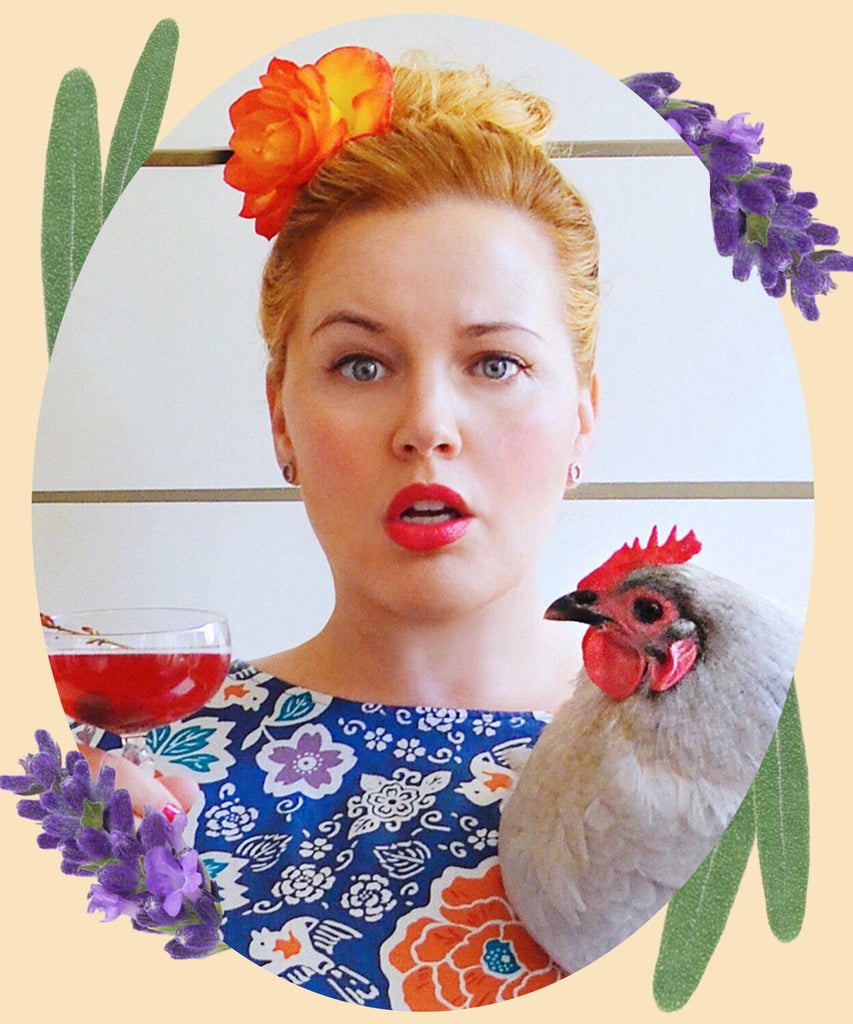Shaken, stirred, or frozen, cocktails in their various delicious forms have another element to incorporate in 2021: Sustainability. As we become more eco-conscious in all aspects of our lives, we’re learning to better appreciate and protect the earth’s bounty, conscientiously celebrating the planet we all share. For cocktails, that looks like reducing food waste, buying local ingredients, and utilizing brands that prioritize sustainability.

Creative mixologist Kate E. Richard, the ringleader behind the tongue-in-cheek garden-to-glass cocktail lifestyle blog Drinking with Chickens and author of Drinking with Chickens: Free-Range Cocktails for the Happiest Hour naturally incorporates sustainability in every drink she makes, from the spirit to the garnish. But you don’t have to be a pro behind the bar to whip up your own sustainable cocktails at home. Ahead, we spoke with Richards about her “progress over perfection” approach to sustainability, how at-home and professional mixologists can be more sustainable, and her go-to Eau de Lavender cocktail, which pairs Patrón Silver with eco-conscious techniques.
Why is making sustainable cocktails important to you?
“Making my beverages as sustainably as possible is a perfect example of how small, seemingly inconsequential modifications to your basic way of living can have a positive ecological impact. It is so easy to fall into an “all or nothing” mindset with sustainability, when little changes like sourcing local ingredients for your drinks — or even growing them yourself — can really make a difference. Progress over perfection! Fresh, seasonal ingredients just make a drink tastier. It’s science.”
As a mixologist, what does sustainability mean to you?
“For me, it’s about striving to maintain a healthy give and take with the environment around me. Obviously, we, as humans, tend to take more than we give, so for me, sustainability is about being more aware of that resource suck and doing whatever I can reasonably do to staunch it. My garden has really highlighted this struggle, and allowed me to see the benefits of my more ecologically conscientious choices: zero pesticides, herbicides, and chemical fertilizers combined with lush, dedicated pollinator-friendly plantings has made the garden absolutely vibrate with happy insects and birds. When they’re happy, the garden is happy, and I reap the benefits of harvesting food and drink ingredients that leave no footprint on the planet.”
What makes your Eau de Lavender cocktail sustainable?
“The Eau de Lavender cocktail recipe [found below] is pretty darned sustainable when you source the bulk of your ingredients locally, organically, and ethically. For me, this means that the egg whites come directly from my backyard hens, and the lemons and lavender are gathered from my organic garden. For anyone who isn’t growing their own produce, these items can be sourced seasonally from a local farmer’s market. Add in locally sourced honey — be extremely mindful of both the amount of bee products you consume and that they are harvested ethically, as the continuing decline of the honeybee is one of the most staggering threats to life on Earth. Bonus points if you select a tequila that implements sustainable measures into its crafting process, such as Patrón Silver. Patrón has prioritized sustainable agave growing practices in addition to reducing its overall emissions, recycling water, and generating fertilizer compost from leftover agave materials.”
Once you’ve actually made the cocktail, how can you extend its sustainability?
“What makes this cocktail extra, extra sustainable, is how you deal with the waste. Make sure those egg yolks and shells and citrus rinds are put to good use, and not into the garbage. In my house, the yolks are consumed by either us or the animals, and eggshells get fed back to the chickens, as they are an important source of natural calcium for the hens, or worked into compost along with the leftover citrus. Using the rinds to infuse more tequila is a great way to stretch them, too. And then they can still go into the compost after that. They can also be used to infuse teas and oils for cocktails. And they could be zested and the zest can be dried and saved indefinitely to be added to flavor drinks.”
What can at-home and professional mixologists do to be more sustainable in cocktail crafting?
“Make local, seasonal, organic ingredient choices whenever humanly possible. Choose liquor brands that have committed to environmentally responsible practices. Be mindful of your waste. There can be so much waste in the cocktail crafting process, especially when working with fresh ingredients. It’s that fresh stuff that can be so easy to put to other beneficial uses with just a little extra effort. And my final, and secretly favorite, suggestion is to make use of vintage glassware. One woman’s trash is another woman’s treasure, let’s keep that old, good stuff outta the landfills.”

Eau de Lavender Cocktail
Ingredients:
1.5oz Patrón Silver
.75oz lemon juice
.75 oz honey syrup (equal parts honey & water)
1 egg white
1 dash lavender bitters
+ optional edible flower for garnish
Method:
1. Combine all ingredients in a shaker and dry shake (without ice) vigorously.
2. Add ice and shake again to emulsify throughly.
3. Strain into a chilled cocktail coupe and garnish with an edible flower.
Learn more about Patrón’s efforts to limit environmental impact here.
THE PERFECT WAY TO ENJOY PATRÓN IS RESPONSIBLY. ©2021.
PATRÓN, ITS TRADE DRESS, AND THE BEE LOGO ARE TRADEMARKS.
HANDCRAFTED IN MEXICO. IMPORTED BY THE PATRÓN SPIRITS
COMPANY, CORAL GABLES, FL. TEQUILA – 40% ALC. BY VOL.
Like what you see? How about some more R29 goodness, right here?
from Refinery29 https://ift.tt/3eqMfqs
via IFTTT
